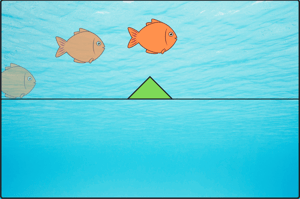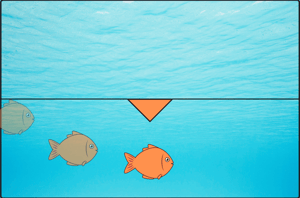How does Neurofeedback work?
Neurofeedback makes possible what sounds like a scenario from a science fiction movie: to direct an object - such a s an aircraft or submarine - up or down while it is sliding across the screen. The only power needed to do that is the power of thoughts. This game-like exercise on the computer is at the center fo the SCP training (training of slow cortical potentials)
Prerequisites for training
Equipment needed includes a PC containing training software, keyboard, mouse, and two screens, a DC-EEG and bio signal amplifier, and a certain number of electrodes (usually 7) to derive the EEG and to control the movement of the eyes and muscles.
The training is suitable for children from preschool age and older. For younger children it is usually too difficult to sit still for a longer time. Their muscle or eye movement would distort the EEG.
It is also important for the success of therapy that the patient is well-resed and motivated for training.
Course of the Neurofeedback Training
Preparation
At the beginning of the first session, the therapist introduces the setting and the training itself and places the patient in front of the screen in a comfortable chair or armchair allowing for a relaxed position. Children in particular are often invited to touch the electrodes, pastes and so on.
Next, the therapist attaches seven EEG electrodes to the head using a special electrode paste. One electrode is placed at the top of the head, two behind the ears and another four near the eyes. The patient does not feel any pain; it is just the same as with the EEG.
It is important that before the electrodes are attached, all locations of these are cleaned with disinfectant and pastes, and freed of skin flakes. Then, the therapist checks every electrode to make sure they have the maximum skin contact.
A series of particular eye movements (up and down, left and right, blinking) makes sure that the computer recognizes and eleminates artifacts in the EEG caused by muscles and eyes during training.
Training
Once the patient is connected to the amplifier via the electrodes, brain waves can be measured, and the slow cortical potentials (SCPs) are filtered out. These signals are converted by the amplifier and sent to a screen where they are displayed as the upwards or downwards movement of an object.


Up or Down
In each session, the patient receives two different types of tasks that are displayed on his or her monitor in the form of a triangle directed to the top or to the bottom of the screen. During each task, the chosen object moves across the screen from left to right. The patient must direct the object in the cued direction - up or down. The patient is only allowed to use the power of his or her thoughts.
If the arrow points up, the patient needs to shift the SCPs into an electrically negative direction, meaning he or she has to activate the brain. If the arrow points down, the task is named deactivation. This means the patient should relax in order to shift the SCPs into an electrically positive direction. These upward and downwards movements of the object reflect the shifts of the SCPs. This way, the patient receives a direct and online feedback of his or her brain activity.
Positive reinforcement through reward
After each successful trial, the patient receives a visual reward, for example a sun of any other positive display. Successful means that the patient managed to direct his or her brain activity in the cued direction for a few seconds. This visual reward reinforces the patient's individual strategy to achieve good resuts. Gradually, the patient manages to make themselves faster and over a longer period in the desired state.
In order to enable the patient to use the new self-regulation skills in everyday life, the patient receives a certain amount of transfer trials during each session. In a transfer trial the triangle indicates the task, but the object is not displayed. The patient learns only at the end of each trial if they successfully managed to move the object into the cued direction. For further exercise at home, the patient is given transfer cards with a downscaled picture of the screen as a memory aid. The child, for example, can use this card to motivate themselves and maximize attentiveness during school situation.
A complete session lasts approximately 45 to 60 minutes. These sessions include preparation, training and evaluation. The training itself is comprised of 80 to 100 trials, lasting approximately 20 minutes. After training has ended, the therapist and patient look at the training data and evaluate performance. They may also compare the current training with previous sessions to see the child's development over the course of therapy. A total of 25 to 40 sessions are necessary, depending on the patient's ability to learn self-regulation.
Find a clinic
Seek innovative and personalized treatment at a clinic near you
I'm a clinician
Learn more about our platform, innovative technologies and training academy for health professionals and researchers.
I'm an investor
Learn more about our vision and plans for growth and access our Investor Room.
Stay up to date with the neurocare platform and our network of clinics
Stay up to date with our platform and clinics
Copyright © neurocare group AG 2026





